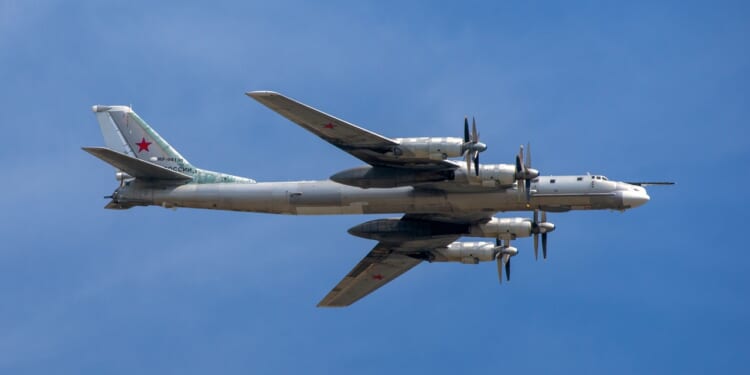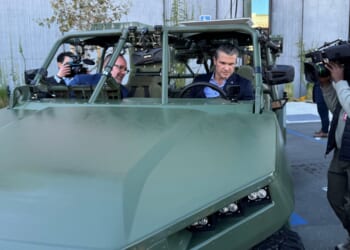Heavy strategic bombers will likely remain beyond reach for most middle power nations—but the world’s three major military powers each operate them.
Only a handful of nations still field true “strategic bombers”—aircraft designed to deliver nuclear or conventional payloads across continents. Remaining in the exclusive club are the three major military powers of the world today: the United States, Russia, and China. These are the only nations on Earth with operational long-range bomber fleets. Each uses them for a different purpose, but all treat them as an assertion of national ambition.
The United States Has the World’s Biggest Strategic Bomber Fleet
The United States has built its nuclear deterrent around a triad, which includes land-based missiles, submarine-launched missiles, and nuclear-capable strategic bombers. The current bomber fleet is itself a triad, consisting of:
- The B-52 Stratofortress, the workhorse of the US strategic bomber fleet, with service dating back to the 1950s;
- The B-1B Lancer, a supersonic bomber first fielded in the 1980s; and
- The B-2 Spirit, a revolutionary “flying wing” stealth bomber first introduced in 1997.
Both the B-52 Stratofortress and the B-2 Spirit are nuclear-capable. Although the B-1 Lancer is currently not approved to carry nuclear weapons—having lost the capability to do so after the START I treaty with Russia in 1991—there is little doubt that it could quickly be outfitted to carry them again during a crisis.
All three of these bomber aircraft are intended to be replaced by the forthcoming B-21 Raider, a flying wing stealth bomber similar to the B-2.
The strategic value of the US bomber fleet is not only strike capacity but in its ability to signal to would-be adversaries. Unlike a nuclear missile—which, once fired, cannot be un-fired—the bombers can take off, be tracked on radar, and turn around, providing visible deterrence that missiles cannot.
Russia Has Two Strategic Bombers
The Russian bomber fleet embodies a similar logic than the United States, albeit with fewer resources to draw upon. It consists of two aircraft:
- The Tu-95 Bear, a turboprop-driven relic from the 1950s; and
- The supersonic Tu-160 Blackjack, first introduced in 1987 and similar in design principles to the B-1 Lancer.
These two aircraft each give Moscow a global-reach option. Both airframes can launch nuclear or conventional cruise missiles without entering enemy airspace.
Complementing the bomber force is Russia’s crop of heavy ICBMs. But it is the bombers which are so often utilized as a geopolitical stage prop—bombing targets in Syria, conducting intrusive flights near Alaska or Japan, and reminding Russia’s adversaries that the Kremlin can still project power away from home.
China Has Kept Its Bomber Program Under Wraps
Relatively little is known about China’s strategic bomber program. It is thought to only have one heavy bomber in active service: the Xi’an H-6, a turbojet-powered strategic bomber first introduced in 1969 and now nearing retirement. China is known to be building the newer Xi’an H-20 flying wing stealth bomber to supplement the aging H-6 fleet, itself an ancient Soviet derivative.
While the H-6 is not especially impressive, the platform still qualifies China for the strategic bomber club. And the H-20, although still under tight secrecy, may well be a platform that gives Beijing the ability to threaten US bases in Guam or Hawaii without relying on missiles.
The H-20’s development reaffirms the signal that China has been sending through other avenues, like an unprecedented naval buildup, island building in the South China Sea, and investment in the J-20 fifth-generation fleet: China has aspirations that extend beyond its mainland shores. In terms of deterrence, the H-6K and the H-20 give China increased flexibility.
Other Nations Have Close Approximations of Strategic Bombers
Below the tier of nations with a true strategic bomber, are a handful of aspiring or regional powers with medium-range bombers or strike aircraft. India has the Su-30MKI and the Dassault Rafale strike aircraft, both nuclear-capable. Israel has the F-15I Ra’am, and although the Israeli government has never publicly admitted to nuclearization, it is an open secret that the F-15I can carry nuclear weapons. Britain and France once had the Avro Vulcan and Dassault Mirage IV, both now retired. But none of these aircraft possess the range, payload, or nuclear role to qualify as strategic bombers. Although Europe likely has the resources to develop a strategic bomber, it has ceded the strategic bomber missions entirely to the US, relying on US bombers that rotate through British bases.
Like Britain and France, who have let their strategic bomber programs lapse, other nations are notable for their lack of strategic bombers. Japan and Germany, for instance, are both industrial powers with relatively advanced aerospace sectors. But each nation is restrained, for various reasons relating to constitutional or political limits. The result is increased dependence on the US, whose bomber fleet functionally accommodates both Germany and Japan.
The reality, for all but a few nations, is that strategic bombers are now, and will likely always be, beyond reach. These machines require vast budgets, overseas bases, and reliable aerial refueling networks—all hallmarks of a superpower, not a regional state.
About the Author: Harrison Kass
Harrison Kass is a senior defense and national security writer at The National Interest. Kass is an attorney and former political candidate who joined the US Air Force as a pilot trainee before being medically discharged. He focuses on military strategy, aerospace, and global security affairs. He holds a JD from the University of Oregon and a master’s in Global Journalism and International Relations from NYU.
Image: Shutterstock / Media_works.


















